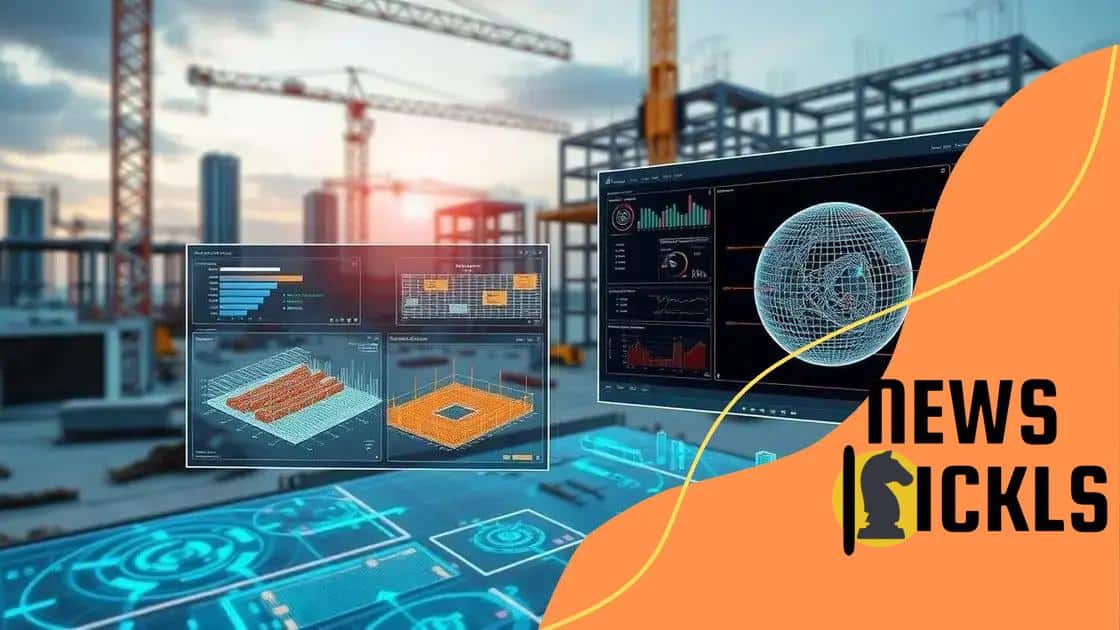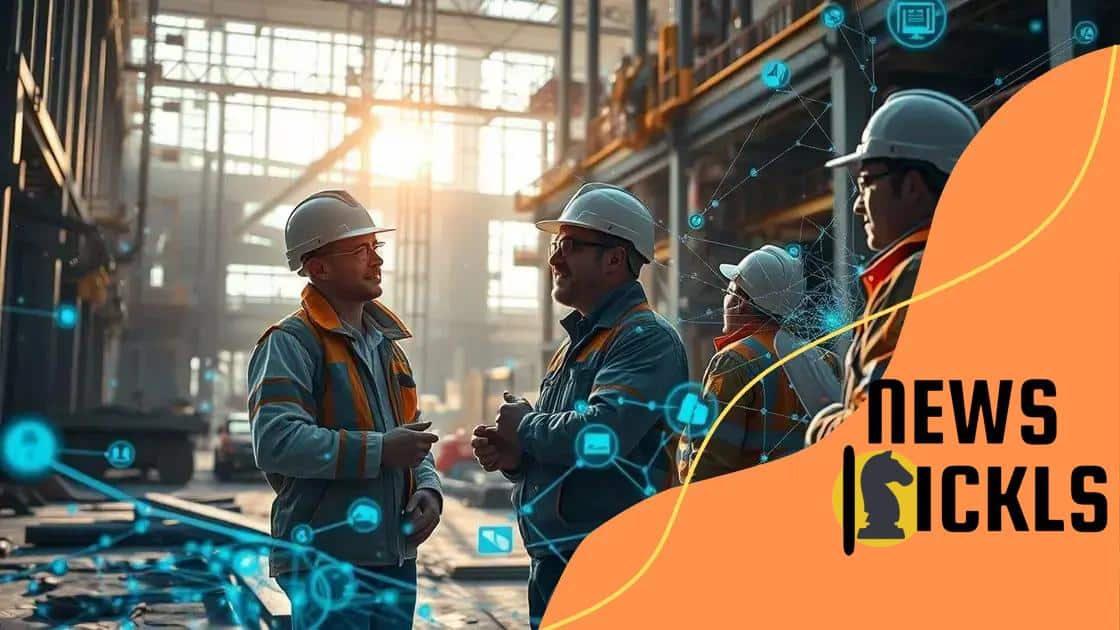How digital twins are revolutionizing construction management

Digital twins are transforming construction management by enhancing efficiency, enabling predictive maintenance, and improving collaboration, while also addressing sustainability and automation trends.
How digital twins are revolutionizing construction management is a topic that’s gaining traction in the industry. These virtual models are not just buzzwords; they hold the potential to transform how we approach construction projects. Curious about how this works? Let’s dive in.
Understanding digital twins in construction
Understanding digital twins in construction is essential for grasping how technology is transforming the industry. A digital twin is a virtual representation of a physical object or system, which is created using real-time data. This technology allows construction managers to simulate real-world conditions and changes, leading to better decision-making.
In construction, digital twins can enhance project outcomes significantly. They provide insight into how buildings will perform throughout their lifecycle. Using simulations, teams can identify potential issues before they arise, saving time and resources.
Key Features of Digital Twins
When we talk about digital twins, it’s important to highlight some of their key features:
- Real-time Monitoring: Sensors collect data from the physical twin, enabling updates and accurate modeling.
- Scenario Simulation: Teams can run simulations to foresee how changes impact the project.
- Data Integration: Digital twins compile data from various sources, creating a comprehensive view.
- Enhanced Collaboration: Teams from different disciplines can access the same data, fostering effective communication.
These features not only streamline project management but also enhance overall efficiency. As teams gain better insights, they can adjust strategies promptly. This adaptability is crucial in the fast-paced world of construction.
Moreover, digital twins support predictive maintenance. By analyzing data patterns, teams can foresee when a part of a structure may fail, allowing for adjustments before issues arise. This proactive approach can save immense costs and extend the lifespan of projects.
As we continue to explore digital twins in construction, it’s clear they are not just a trend. They represent a shift toward more innovative building practices. Enhancing project transparency and performance through technology is the future of construction.
Ultimately, grasping the concept of digital twins in construction leads to greater project success and innovation. The blend of technology with construction practices creates opportunities for businesses to thrive in an evolving industry.
Key benefits of adopting digital twins
The key benefits of adopting digital twins in construction are transformative. These virtual models provide valuable insights, leading to improved efficiency and reduced costs throughout the lifecycle of a project. By utilizing real-time data, teams can make informed decisions and enhance project outcomes.
Improved Efficiency
One significant advantage is improved efficiency. With a digital twin, construction teams can monitor the status of a project continuously. This real-time tracking allows for immediate adjustments, minimizing delays and resource waste.
- Enhanced Planning: Digital twins facilitate better planning by allowing teams to visualize the entire project in a virtual environment.
- Resource Optimization: Teams can allocate resources more effectively, ensuring every element is used wisely.
- Risk Mitigation: Identifying potential issues before they occur helps in reducing the risk of costly mistakes.
Another noteworthy benefit is the cost savings achieved through data-driven insights. By predicting maintenance and operational needs, teams can avoid unexpected expenses, enhancing the overall budget management.
Collaboration and Communication
The use of digital twins also fosters better collaboration among project stakeholders. Everyone from architects to engineers can access the same information, ensuring everyone is on the same page. This openness leads to stronger communication and less chance of misunderstandings.
In addition, digital twins provide a platform for ongoing learning. As teams analyze performance data, they can refine their processes for future projects. This continuous improvement cycle ensures that each project benefits from the knowledge gained in previous ones.
Overall, the adoption of digital twins brings substantial benefits to construction management. The combination of enhanced efficiency, cost savings, improved collaboration, and ongoing learning creates a compelling case for integrating this technology into construction practices.
Challenges in implementing digital twins

Implementing digital twins in construction comes with a range of challenges that organizations must navigate. Understanding these obstacles is crucial for a successful integration of this technology. One of the primary issues is the high initial cost of setting up digital twin systems, which can deter companies, especially smaller ones.
Data Integration Challenges
Another notable challenge involves data integration. Digital twins rely on vast amounts of data from different sources. Ensuring this data is consistent and compatible can be a significant hurdle. Organizations must invest in robust data management systems to make this integration seamless.
- Inconsistent Data Quality: Poor quality data can lead to unreliable digital twin models.
- Legacy Systems: Integrating older systems with new technology often creates difficulties.
- Real-time Data Acquisition: Maintaining real-time data flow demands advanced technology and infrastructure.
Additionally, there is often a skills gap within organizations. Many employees may lack the expertise needed to work with digital twin technology, which can slow down adoption. Companies may need to invest in training and professional development to build the necessary skills.
Change Management
Adopting digital twins also requires effective change management. This process can be met with resistance from employees who are accustomed to traditional methods. Proper communication and demonstrating the benefits of digital twins can help ease this transition.
Finally, regulatory and compliance concerns can pose challenges when implementing digital twins. Organizations must ensure they meet all industry regulations while utilizing advanced technologies. This need for compliance can complicate the integration process and add to the timeline.
Overcoming the challenges associated with digital twins is essential for unlocking their full potential in construction. By addressing these obstacles head-on, organizations can position themselves for greater efficiency and success in the future.
Real-world applications and case studies
The real-world applications of digital twins in construction are both impressive and varied. Many companies are already harnessing this technology to improve project outcomes and enhance efficiency. Understanding these applications can help others see the value of digital twins.
Energy Management
One of the most notable uses is in energy management. Digital twins allow construction teams to simulate the energy performance of buildings before they are built. By analyzing this data, teams can make design choices that reduce energy consumption. This application is particularly relevant as businesses aim to meet sustainability goals.
- Building Performance: Evaluate how different materials influence energy efficiency.
- Cost Analysis: Determine the cost benefits of efficient energy usage over time.
- Optimization: Modify designs based on energy modeling results to achieve better performance.
In addition to energy management, digital twins are also being used for maintenance scheduling. Predictive maintenance powered by digital twins enables construction firms to forecast when equipment or systems may fail. This foresight ensures timely repairs, reducing downtime and associated costs.
Project Monitoring
Another significant application is in project monitoring. Digital twins provide an ongoing view of a project, allowing teams to track progress against timelines. This real-time insight leads to faster problem resolution and keeps projects on schedule.
Companies like Siemens have successfully used digital twins for infrastructure projects, enabling improved control over complex systems. Projects can move more smoothly with this level of oversight. Similarly, the construction giant Autodesk partners with firms to implement digital twins across various sectors, enhancing collaboration and project management.
The versatility of digital twins means they can adapt to different areas of construction. Whether in urban planning, healthcare facility design, or industrial projects, their impact is clear.
By leveraging case studies and real-world examples, it’s evident that digital twins are not merely theoretical concepts. They represent a practical step forward in the construction industry, paving the way for innovative practices and better project outcomes.
Future trends in construction management with digital twins
The future trends in construction management with digital twins are promising and full of potential. As technology continues to evolve, so does the integration of digital twins in various aspects of construction. This innovation is expected to shape how projects are designed, managed, and executed.
Increased Automation
One of the standout trends will be the increased automation of construction processes. Digital twins can streamline operations by automating data collection and analysis. Machines equipped with sensors will feed data into the digital twin model, allowing for real-time updates and analyses. This can significantly reduce manual work and enhance productivity on-site.
- Robotic Integration: Expect to see more collaboration between digital twins and robotics for construction tasks.
- Data-Driven Decisions: Improved data analytics will allow teams to make quicker, more informed choices.
- Seamless Workflow: Automation will integrate various stages of construction, from design to execution.
Moreover, sustainability will take center stage in future construction practices. Digital twins will play a crucial role in evaluating a project’s environmental impact. By simulating different scenarios, teams can optimize designs for energy efficiency and reduced waste.
Advanced Collaboration
The landscape of project collaboration will also evolve. Digital twins will foster enhanced collaboration between different stakeholders. Virtual meetings utilizing digital twins will allow teams to visualize and discuss projects in real-time, regardless of their physical location. This can lead to improved communication and stronger teamwork.
As more data becomes available, predictive analytics will gain importance. Teams will be able to anticipate issues before they occur, allowing for proactive problem-solving. This trend will not only save time but also significantly reduce costs associated with project delays.
Additionally, advancements in augmented reality (AR) and virtual reality (VR) will complement digital twins. By combining these technologies, teams can immerse themselves in a project’s environment, enabling more effective planning and design decisions. This immersive experience will provide deeper insights into potential challenges and opportunities.
Ultimately, as we look ahead, the future of construction management with digital twins is bright. The combination of automation, sustainability, improved collaboration, and immersive technologies will redefine how projects are approached and executed. Organizations that adopt these innovations will likely lead the way in the competitive construction industry.
FAQ – Frequently Asked Questions about Digital Twins in Construction
What are digital twins, and how do they work in construction?
Digital twins are virtual replicas of physical structures or systems, using real-time data to simulate and analyze performance and facilitate decision-making.
How can digital twins improve project efficiency?
Digital twins enhance project efficiency by providing real-time insights, enabling predictive maintenance, and allowing for timely adjustments in response to changes.
What are some challenges in implementing digital twins?
Challenges include high initial costs, data integration issues, and a skills gap among employees who may need training to utilize the technology effectively.
What future trends can we expect with digital twins in construction management?
Future trends include increased automation, enhanced collaboration through immersive technologies, and a stronger focus on sustainability in construction practices.






